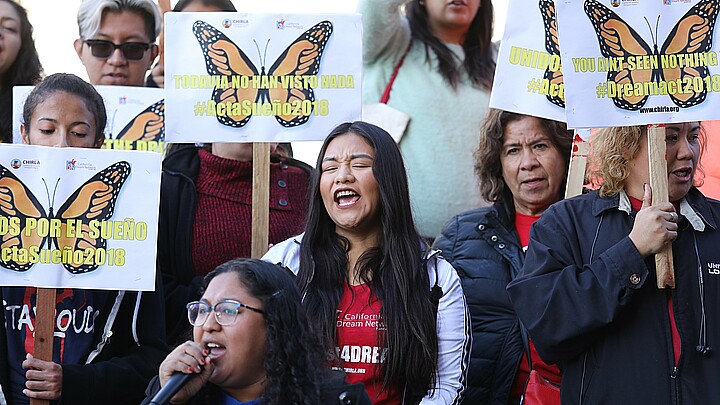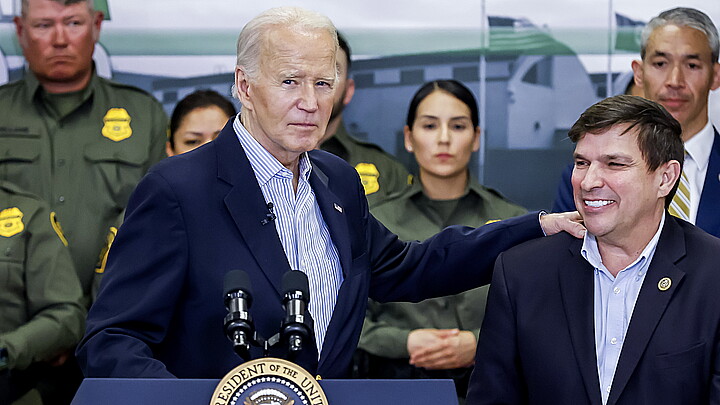Immigration
Strategists who predicted Dems would become majority party sound alarm about Hispanic shift to GOP
A new book published by political scientists John B. Judis and Ruy Teixeira says that many Hispanic Americans feel betrayed by the Democratic Party’s policies on open immigration, and that Latinos are following the white working class in a dramatic shift toward the Republican Party

November 6, 2023 9:09am
Updated: November 6, 2023 9:19am
A new book published by political scientists John B. Judis and Ruy Teixeira says that many Hispanic Americans feel betrayed by the Democratic Party’s policies on open immigration, and that Latinos are following the white working class in a dramatic shift toward the Republican Party.
The book, “Where Have All the Democrats Gone? The Soul of the Party in an Age of Extremes,” is scheduled to be published Tuesday, and is a surprising turn from the authors’ 2002 renowned work, “The Emerging Majority.’
That book suggested the Democratic Party was destined to become the majority party of the United States in the early part of the 21st century due to changing demographics.
After covering the 2002 elections, Judis and Teixeira argued that the fastest-growing areas of the U.S. were seeing a new wave of “progressive centrism” and turning away from Republican attempts to ban abortion, reduce environmental regulations and privatize social security.
But now the authors say the Democratic Party has taken a dangerous turn with its far liberal immigration and open border policies, the result of a miscalculation among Hispanic voters. Democrats wrongly predicted Hispanic Americans would support liberal immigration policies based on their ancestry and ethnicity, not taking into account they may have the same fears about job loss as the white working class.
Excerpts of the book were obtained in advance by the Wall Street Journal, which explained the authors gathered their data from focus groups run by progressive organizations last year. Many of the participants were from different states across the nation and voted for Joe Biden in the 2020 presidential election, but had reservations about voting Democratic in the 2022 midterm election.
Many of the participants conceded they felt the Biden administration was hampering efforts by Texas Gov. Greg Abbott and Florida Gov. Ron DeSantis to enforce immigration law.
“Trump’s border policy was not to have an influx of migrants. President Biden reversed that. There are now more than two million expected this year,” one woman said. Another added that DeSantis and Texas are “the first line of defense. They are not getting the support they need,” the authors wrote.
The book then illuminates Latinos’ frustration with the immigration policies of the Biden administration as hundreds of thousands of migrants continue to take advantage of New York’s sanctuary city law along with and other such cities.
It also highlights how some Democratic officials, including New York City Mayor Eric Adams and Gov. Kathy Hochul have expressed frustration as the Big Apple has endured overcrowding.
Currently, frustration about illegal immigration can be broken down as expected. In March 2021 Gallup reported that 41% of Democrats are frustrated while 56% of independents and 91% of Republicans feel similarly.
However, when it comes to education and working class, the numbers are surprising. While only 46% of the college-educated are concerned, 64% of those who have did some college, and a whopping 69% of those with only a high school education or less are frustrated.
According to the authors, the reveal that by ignoring concerns about illegal immigration, Democrats have lost significant of support among working-class voters who were once the anchor of the party.
In fact, Democrats were once known as immigration hardliners. Shortly after the Industrial Revolution and World War I, immigrations started tightening. Democrats such as President Franklin D. Roosevelt was able to use immigration restriction as a way to rally blue collar workers behind the New Deal during the 1930s.
Shortly after Tokyo bombed Pearl Harbor in 1941, Roosevelt by executive order ordered Japanese into internment camps in the Midwest.
From the Johnson era of Civil Rights, through the Reagan Bush era and into the Clinton presidency from 1965 to 1995, more than 20 million immigrants entered the United States, triple what had entered the previous three decades.
Legislation signed by President Lyndon Johnson in 1965 loosened immigration restrictions, but it was not intended to create an overflow of migrants, the authors argue.
Johnson’s attorney general, Nicholas Katzenbach once told a Senate committee, “This bill is not designed to increase or accelerate the numbers of newcomers permitted to come to America. Indeed, this measure provides for an increase of only a small fraction in permissible immigration.”
The clincher, the authors argue is that Johnson’s legislation allowed family reunification, which arguably contributed to “chain migration,” a trend that has allowed immigrants to invite their family members, and spouses who could then invite their relatives as well.
The result was a massive shift in U.S. immigration policy that resulted in large-scale legal migration.
For a while Democrats continued to have support from blue collar voters because the party promised to shield American jobs with immigration restrictions.
But after President George W. Bush’s popularity skyrocketed in the wake of the Sept. 11 attacks, Democrats began a strategy to support a path for citizenship for undocumented immigrants. Some of those immigrants have entered the work force, creating competition for Hispanic Americans.
For two decades, the authors argue, Democrats turned a blind eye to the growing frustration among Latino working communities and continued to believe that investing in illegal immigration would send a significant return on future Hispanic votes.
As it turns out, supporting the decriminalization of illegal immigration and pushing for taxpayer-supported health insurance to undocumented migrants created a backlash.
Republicans were not blind to this shift and have since capitalized on it. The authors believe while many liberals expected Hispanics to take offense to many of candidate Donald Trump’s offensive comments about Latino migrants in 2016, their prediction was far off.
The aforementioned March 2021 Gallup Poll also reported that 60% of Americans worried “a great deal” or a “fair amount” about illegal immigration, and eligible voters who actually cast a ballot are often those with concerns about the issue as opposed to those who are comfortable with the growing issue.
On July 15 last year, the American Enterprise Institute announced it was appointing Teixeira as a senior fellow to "focus on the transformation of the party coalitions and the future of American electoral politics," and cited his work as having "charted the evolution of the American electorate and its implications for our democracy."
John B. Judis and Ruy Teixeira’s book, “Where Have All the Democrats Gone? The Soul of the Party in an Age of Extremes,” will be published Nov. 7 by Henry Holt.










